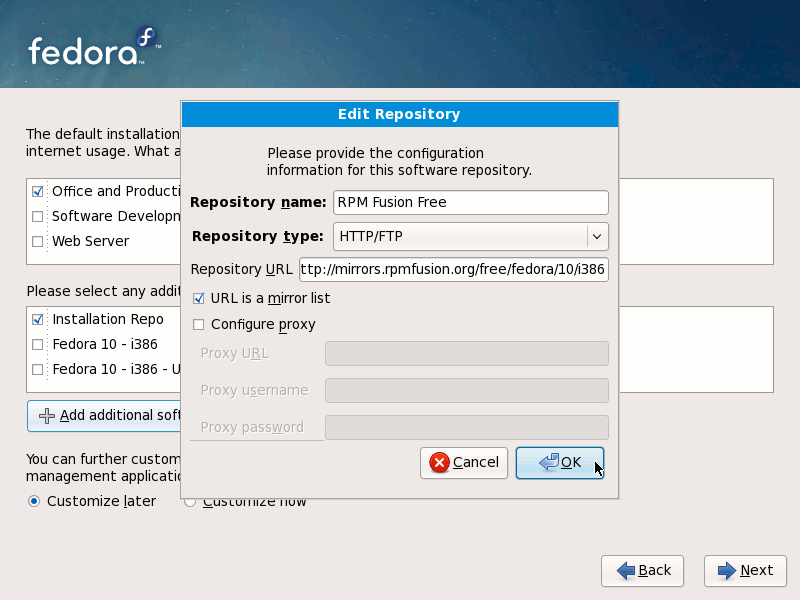|
Size: 3940
Comment:
|
Size: 4242
Comment:
|
| Deletions are marked like this. | Additions are marked like this. |
| Line 42: | Line 42: |
| Now simply continue installing Fedora. | Now simply continue installing Fedora. A subset of the RPM Fusion package set will automatically get added to your install -- that includes the rpmfusion-release rpms that contain the .repo files for RPM Fusion as well as some commonly used packages like gstreamer-plugings-ugly if you stick to the default package set that Fedora defines. |
Using RPM Fusion at installation time
In Fedora 10 and later Anaconda (the Fedora installer) is capable of activating and using the RPM Fusion repositories during install.
Adding the RPM Fusion repositories during install
Before you start installing Fedora making sure you have a supported network card and over which a connection to the internet can be established. Start the install and move through the different anaconda screens where you select language, keyboard layout, root password and target volume until you get to the Additional Tasks screen:
Then follow these steps to enable the RPM Fusion free repository:
In the Additional Repositories section, click the Add additional software repositories button.
- In the Edit Repository dialog, set the Repository name: 'RPM Fusion Free'
Set Repository type: HTTP/FTP
- Set Repository URL depending distribution version and the architecture. For Fedora 10 on i386 use
http://mirrors.rpmfusion.org/free/fedora/10/i386
Click URL is a mirror list
Click OK

Once you enabled the free repository you can enable the RPM Fusion nonfree repository:
After enabling the free repository in the Additional Repositories section, click the Add additional software repositories button again.
In the Edit Repository dialog, set the Repository name: RPM Fusion Nonfree
Set Repository type: HTTP/FTP
- Set Repository URL depending distribution version and the architecture. For Fedora 10 on i386 use
http://mirrors.rpmfusion.org/nonfree/fedora/10/i386
Click URL is a mirror list
Click OK

Now simply continue installing Fedora. A subset of the RPM Fusion package set will automatically get added to your install -- that includes the rpmfusion-release rpms that contain the .repo files for RPM Fusion as well as some commonly used packages like gstreamer-plugings-ugly if you stick to the default package set that Fedora defines.
For other architectures like x86_64 or PPC/PPC64, change Packages in the nonfree repository require packages from the free repository to be available, hence you Repository URL for i386 RPM Fusion Free Release for F10 http://mirrors.rpmfusion.org/free/fedora/10/i386 RPM Fusion Nonfree Updates for F10 http://mirrors.rpmfusion.org/nonfree/fedora/10/i386 RPM Fusion Free Release for F10 http://mirrors.rpmfusion.org/free/fedora/updates/10/i386 RPM Fusion Nonfree Updates for F10 http://mirrors.rpmfusion.org/nonfree/fedora/updates/10/i386
A subset of the RPM Fusion package set will automatically get added to your install when you enable the RPM Fusion repositories in Anaconda. That for example includes, but is not limited to the gstreamer-plugings-ugly package. But you of course can select or deselect packages during install if you select the Many more packages from RPM Fusion can be found in the group ![]() Important notes:'':
Important notes:'':
i386 to x86_64, ppc, or ppc64 in the repository URL.
More information's
Selecting RPM Fusion packages during install

